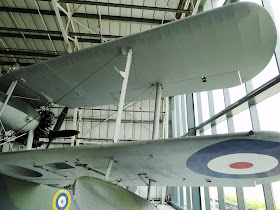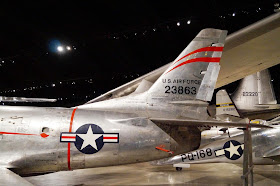Subject:
|
Akula Class Russian Attack Submarine
|
Scale:
|
1/350
|
Manufacturer:
|
Hobby Boss
|
Price(December2013):
|
US$20,00
|
Construction:
|
Out-of-the box construction.
|
Extras:
|
None
|
Comments
|
This is another one of the very nice submarine kits from Hobbyboss. There are not too many parts and fit is great, ideal for a weekend project. Painting was done with Tamiya acrylics and markings are form the kit.
|
Sunday, May 31, 2015
Boats vol.15: Akula class Russian attack submarine
Friday, May 29, 2015
Aircraft walkaround vol49: Supermarine Walrus (Seagull V)
Subject: Supermarine Walrus (Seagul) V
Location: RAF Museum, London, UK 2013
Comments:The Walrus amphibian formed a vital part of the British Air-Sea Rescue service during World War Two. Slow and ungainly, the Walrus was nevertheless a most welcome sight for more than 7500 Allied airmen who were saved from the sea after they had been forced to 'ditch'. The prototype appeared in 1933, the latest in a long line of successful amphibians designed by R.J. Mitchell. An order for twenty-four followed from the Royal Australian Air Force who required a reconnaissance amphibian that could be catapulted, with full operational load, from warships. Known to the Australians as the Seagull V, the type was also ordered for the Royal Air Force under the name Walrus.All the metal hulled Walrus Mk I aircraft were manufactured by the parent company Supermarine. However, with Spitfire fighter production building up, responsibility for construction was transferred to Saunders Roe Ltd.(Saro). Most ASR Walruses were the wooden hulled MkII built by Saro which provided a marked improvement in take off and landing on water. When production ended in January 1944 Saro had built 461 of the total of 746. Perhaps surprisingly, it was the first British squadron service aircraft to have a fully retractable main undercarriage and a completely glazed cockpit.
Friday, May 22, 2015
Aircraft walkaround vol.48: Piasecki H-25 Army Mule/HUP Retriever
Subject: Piasecki H-25 Army Mule/HUP Retriever
Location: Intrepid Air and Sea Museum, New York, USA, 2014.
Comments: The Piasecki H-25 Army Mule/HUP Retriever was a compact single radial engine, twin overlapping tandem rotor utility helicopter developed by the Piasecki Helicopter Corporation of Morton, Pennsylvania during the late 1940s and produced during the early 1950s. The company changed its name in the 1956 to Vertol Aircraft Corporation and subsequently was bought by Boeing Aircraft Company in 1960, and becameBoeing-Vertol. The design was a product of a competition by the U.S. Navy in 1945 for a compact utility/rescue helicopter to operate from ships including aircraft carriers, battleships, and cruisers. The prototype was designated as the XHJP-1, and first flew in March 1948. It was selected for production, as the HUP-1 in a side-by-side flight evaluation against the Sikorsky XHJS-1. It entered service with the navy in 1949. Versions of the HUP built for the U.S. Army were designated H-25 Army Mule. The tandem overlapping rotor configuration was a development by Piasecki and was used in future helicopter designs by the company and successors including the H-21, HRB-1/CH-46, and CH-47. The design featured two three-bladed, 35-foot-diameter (11 m) rotors in tandem in which blades could be folded for storage. The HUPs were powered by a single Continental R975-46 radial engine, with a take-off rating of 550 hp (410 kW). To provide rescue without crew assistance, an electrically-operated door, available after folding the copilot’s seat forward, opened through which a rescue sling could be lowered from an overhead winch. The HUP was produced for the navy in four versions: HUP-1, -2, and -3. The HUP-2 was the first production helicopter equipped with an auto-pilot. The US Navy also tested a system called 'Raydist that allowed an unmanned HUP-2 to be directed from a ground station and by radio ordered to hover within five feet of the desired point. Edo tested a HUP-2 with a fiberglass hull and outrigger floats for amphibious operations. In addition to those delivered to the U.S. Navy and Army the HUP/H-25 helicopter was also delivered to the Canadian and French Navies. A total of 339 aircraft were delivered over the 20-year life of the aircraft. The US Army H-25 designation was adopted by the other services in 1962. The final units were withdrawn from US service in 1964. It also served with the French Navy from 1953 to 1965. (http://en.wikipedia.org/wiki/Piasecki_HUP_Retriever)
Sunday, May 17, 2015
Aircraft walkaround vol.47 : North American F86D Sabre Dog
Subject: North American F86D Sabre Dog
Location: USAF Museum, Dayton, Ohio, USA, 2014.
Comments: The YF-95 was a development of the F-86 Sabre, the first aircraft designed around the new 2.75-inch (70 mm) "Mighty Mouse" Folding-Fin Aerial Rocket (FFAR). Begun in March 1949, the unarmed prototype, 50-577, first flew on 22 December 1949, piloted by North American test pilot George Welch and was the first U.S. Air Force night fighter design with only a single crewman and a single engine, a J47-GE-17 with afterburner rated at 5,425 lbf (24.1 kN) static thrust. Gun armament was eliminated in favor of a retractable under-fuselage tray carrying 24 unguided Mk. 4 rockets, then considered a more effective weapon against enemy bombers than a barrage of cannon fire. A second prototype, 50-578, was also built, but the YF-95 nomenclature was short-lived as the design was subsequently redesignated YF-86D. The fuselage was wider and the airframe length increased to 40 ft 4 in (12.29 m), with a clamshell canopy, enlarged tail surfaces and AN/APG-36 all-weather radar fitted in a radome in the nose, above the intake. Later models of the F-86D received an uprated J-47-GE-33 engine rated at 5,550 lbf (24.7 kN) (from the F-86D-45 production blocks onward). A total of 2,504 D-models were built. (http://en.wikipedia.org/wiki/North_American_F-86D_Sabre)




















































